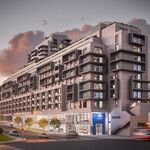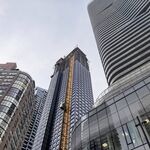Tuesday is the big day...several articles in the Star today...
Pier F is pointing straight to the future
TheStar.com - News - Pier F is pointing straight to the future
Not just another $800 million pretty place. They're banking on it to really put Pearson on the map
January 27, 2007
Bill Taylor
Feature writer
This is one secret you can tell in Pier F ...
The new finger outstretched from Terminal 1 at Pearson International Airport isn't just a much-needed extension. It points to the future – a symbol of Toronto's reaching for a bigger share of the aviation market.
With room to build three more piers, that finger could eventually grow into a hand.
The Greater Toronto Airports Authority wants Pearson to be a major North American hub, taking on New York and Chicago and offering passengers transferring between international flights a way to avoid the United States and its increasingly draconian security regulations.
American paranoia could become a selling point for Pearson as a relatively painless way-station for globetrotters, especially those travelling between South America and Europe and Asia.
That's an open secret.
Anything else – like saying "I love you" to someone you shouldn't – and you might think twice. You could be telling the world.
Richard Serra's sculpture, Tilted Spheres, which dominates the 37,000-square-metre "hammerhead" at the end of the pier, is like the Whispering Gallery in St. Paul's Cathedral – it transmits sound. Say something quietly at one end of the curved sheets of steel and the people at the other end will hear you.
Pier F, opening at midnight Monday as Terminal 2 dies unmourned, is full of biggers, betters, longers and fasters.
Biggest duty-free store; fastest moving walkway, bigger customs hall, more remote check-in terminals, more baggage carousels, easier ... everything.
Chief among the bad things that are disappearing is the evil Terminal 2, with its low ceilings, harsh lighting and lack of room. Even on a quiet day, it made you irritable. At busy times, as the lineups grew and your personal space shrank, it was one big temper-tantrum flashpoint.
The infield satellite terminal, with an irksome bus ride out to the planes, is being mothballed. It's likely only to be used a few times a year.
With an $800 million construction tab, Pier F invites superlatives, demands a "gee whiz!" But what's even more significant is that for the first time in a long time, Pearson International isn't simply replacing existing facilities.
"This is an addition," says GTAA spokesperson Scott Armstrong. "An addition to something new, at that. The new Terminal 1. We're adding capacity so we can be aggressive in going after new airlines and new routes. We're currently handling 31 million passengers a year. Pier F means we can now handle 38 million."
The aim is to handle them faster, with less muss, less fuss (you'll never do away with airport muss and fuss entirely) and get them from where they've come from to where they're going in one seamless manoeuvre.
Upgrades over the past decade, including new runways and taxiways, mean the airport could accommodate 50 million passengers a year. "We expect to reach that by 2020," Armstrong says. "Until now, the terminals have always been the choke-point for airport capacity."
Two gates in the Hammerhead can handle the giant new double-decker Airbus A380, which can carry more than 500 passengers. It's set to enter service by 2008. Armstrong expects a shakedown flight to Toronto some time this year to try out the airport facilities.
Jetliners, super-jumbo or not, are big and need a lot of space. Walking considerable distances is a fact of airport life. From the parking garage to the hammerhead is almost a kilometre – about the same as walking up Yonge St. from Queen's Quay to King. Even Hong Kong's Chek Lap Kok, constantly vying with Singapore's Changi as the world's top-rated airport, has signs telling passengers how long it'll take them to reach their departure gate – up to half an hour or more.
Armstrong says that, given a clear run with no check-in or security lineups – unlikely as that may be – you can be at the hammerhead in about 10 minutes. Thanks to North America's first high-speed moving walkway, a two-stage conveyor belt (no neck-snapping acceleration and deceleration when you get on and off) whisking you along at three times normal walking speed.
Along the way, you may notice through one of the huge windows a rectangle of asphalt on the concrete apron where jets taxi. That's the "footprint," Armstrong says, of the old Terminal 1, a concrete bunker with low ceilings and bad lighting that always had the feel of escaping from Soviet-era eastern Europe. This ghostly image on the ground is a reminder of how tiny and cramped it was. Terminal 2, soon to be torn down, was almost as bad.
Terminal 3, built in 1991, will continue to handle some U.S. and international airlines, including most charter flights. There will be no Terminal 2 for the foreseeable future, though the old one will be forgotten but not exactly gone. The goal is to recycle 98 per cent of the building, with metal, glass and copper cable being sold. Armstrong says 100 per cent of the concrete will be crushed on-site for the base layer of any new apron that is laid.
The green theme continues in the way lights are switched off automatically, depending on the available natural light. The airport was crippled during the Great Blackout of 2003 because it was down to 50 per cent power, cutting in half the speed with which planes could be dealt with. Pier F, Armstrong says, wouldn't be affected by a similar blackout. It has its own power plant.
Terminal 3 and the new Terminal 1, which opened in April, 2004, are spacious, light and airy. Pier F continues this with high ceilings and long skylights. The planners have identified potential roadblocks and tried to deal with them. For instance, passengers transferring between international and American flights won't have to schlep all the way down the pier and back. Satellite customs and immigration posts have been set up at the hammerhead. To catch your connecting flight, you just go up or down a level.
Passengers on some routes used to be bused to the infield satellite terminal. That will only be used at peak periods, such as Christmas, March break and next time Detroit hosts the Superbowl.
Every big airport has to make do with remote terminals.
At London's Heathrow, many planes are a 20-minute bus ride from the terminals. Being stuffed onto a bus as crammed as a TTC streetcar at rush-hour is the last thing you need after a long, overnight flight.
Pier F's customs hall, Armstrong says, is one of the biggest in North America. There are more baggage carousels (served by 11 kilometres of baggage belts) so passengers from two or three flights won't be jostling to get their luggage from one place. But it's still a bothersome toonie to get a baggage cart.
They're even taking some of the hassle out of spending your money. The 930-square-metre duty-free area is arguably the largest on the continent, with everything from booze to mp3 players – and the inevitable maple syrup – in one place. There are other stores outside the duty-free area and a wide choice of food and drink, from Starbucks to a rum bar.
That's good business sense. But there's smart thinking going on all over Pier F. Room has been made to put in a road between planes parked at the gates and the building itself. When a jet moves, all ground transport around it – fuel-tankers, catering trucks, whatever – has to stop. If a jet is pushed back from the gate and then develops a problem, it can produce a traffic snarl-up that delays other aircraft. But this terminal-hugging road avoids that.
Arrivals areas aren't always inviting. Terminal 2 and the old Terminal 1 had dingy little spaces where everyone crowded forward, elbows jostling, to spot their loved ones. Pier F has a big open space where Pier F joins Terminal 1. Passengers emerge on a platform raised about half a metre so they're easily visible without anyone being crushed.
So simple and, when you've seen it, so obvious. But who figures all this stuff out?
"Someone smarter than me," says Armstrong. "There's a logistics staff dedicated to bridges, gates, baggage handling and the use of space and facilities."
For anyone arriving who can't speak English or French, staff can handle at least 60 languages. "Our information people have to be tri-lingual," Armstrong says. "We try to have different `tri's.'"
In 2005, Pearson was rated 17th best airport in North America and 29th in the world. It's expected now to climb in the ratings.
Without seeing it full of people, it's impossible to judge how well it'll live up to its promise. But it looks terrific – spacious, laid out logically and ingeniously planned. It hasn't been cobbled together in the hope that it'll work fairly well most of the time. It's meant to be hospitable while you're there but to keep you there for as short a time possible.
Inevitably, sooner or later, passengers are going to find themselves stuck in the hammerhead waiting for a long-delayed flight. The fixed arms on the seats mean you can't stretch out and sleep. And the upper level has a couple of bridges that have glass walls. If you're jet-lagged and not paying attention, it can seem suddenly as if there's nothing there to stop you falling off. Instant vertigo.
Otherwise, Pier F looks as good as anything Hong Kong or Singapore or Amsterdam's Schiphol – a perennial Top 5 contender – can offer. It should be as pleasant an experience as flying in these overcrowded times can be.
But any airport lives and dies by how easy it is to access. Even a rusty old clunker like Heathrow has a state-of-the-art rail link that connects with central London in less than 20 minutes. Hong Kong has a similar service (that can even take you to the local Disney World). Passengers using Pearson as a hub to connect to other destinations won't care. But for those starting and ending their journeys in Toronto, getting to and from the airport remains the worst part of the experience. We greet the world with a broad and welcoming smile but it rapidly turns into a gap-toothed grin.
That should be a guilty secret.




